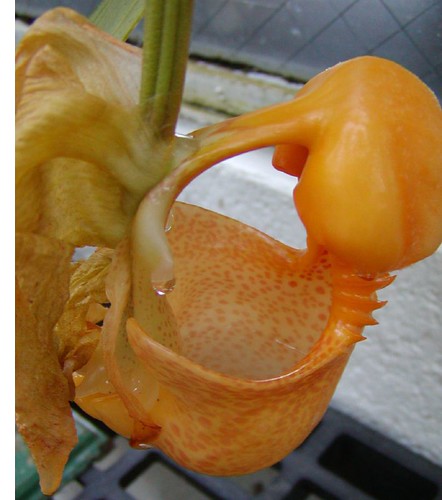
THE BUCKET ORCHID
Darwin in his book 'On the pollination and fertilisation of Orchids' included a description of the pollination of the Bucket Orchid, Coryanthes speciosa.
He was so surprised on receiving the description that until he checked and found that it was a respectable botanist who had made the report, he would not credit it.
The BBC have filmed it happening, and the film is probably available from them.
The orchid's labellum is shaped as a bucket, and above the bucket, on another petal, is a gland which secretes a liquid, probably water, which drips into the bucket and accumulates in it.
There are some photos here:
http://blogs.salon.com/0001330/categ...006/06/29.html
The bucket possesses three remarkable features.
1 Cut into the outer side of the bucket, away from the main flower structure, is a slit, which functions as an overflow: so when the liquid reaches a level about half a centimetre BELOW the upper edge of the bucket, it overflows, so at no time is it ever full to the brim.
2 On the opposite side, inside the bucket, and below the level of the liquid, is what looks for all the world like a little step.
3 The outer lip of the bucket is made of some material which is intensely attractive to the blue euglossine male bee.
The bees come and struggle to get at the lip of the bucket, and of course, in the struggles one falls in sooner or later.
Because the walls of the bucket are smooth, he cannot get a grip EXCEPT at the point where there is the aforementioned step. Wet and bedraggled, he climbs on to the step and out, right into the heart of the flower.
As he enters the tube formed by the other petals, he is suddenly clamped and held for a few moments, unable to move or escape, and on to his back, the anthers are pressed.

On the anthers, there is a glue, which takes exactly the same amount of time to dry, as he is held motionless. It dries, he buzzes off, and goes to another flower where the process is repeated - and so the pollen from the anthers reaches the stigma, thus fertilising the orchid.
Darwin also noted that a phenomenon known as pollinarium bending occurred. The term refers to the manner in which orchid pollinaria start to bend after an 18- to 20-second interval after attaching to a visiting insect. The bending mechanism prevents self-pollination of the orchid.
It so happens that only one species of bee comes to a particular species of Coryanthes.
The probability of these features coming together by chance is astronomically small.
1 The structure of the labellum as a bucket is remarkable in itself
2 The gland above is obviously placed there to produce the liquid for the bucket. Imagine it producing liquid with no bucket there, or a bucket there with no liquid coming!
3 The overflow is there for the designed purpose of preventing the liquid from flowing out, over the top of the bucket. If it could flow over the top, the bee, when he fell in, could simply float out over the edge, and thus defeat the purpose of the exercise.
4 The little step, contrived and placed there for the express purpose of preventing the bee drowning, also forces him to enter the heart of the flower.
5 The flower has a designed clamping action, with a timer built in, exactly matched to the drying time of the glue on the anthers.
6 The anthers stick to his back, and do not impede his flight to another plant after he has dried off.
7 The stigma of the flower is positioned on the top petal of the flower, to make sure that it is in the correct position to receive the pollen when the bee arrives. If it was on the underside of the flower, then it would never receive any pollen.
We won't go into the complexities of anther construction until the post on mitosis and meiosis are completed.
8 The glue on the anthers is exactly right for the purpose, and its chemical composition known, and the manufaturing technique as well.
Having read all that, it is no wonder that Darwin staggered at the description. He said that the orchids employed a 'beautiful contrivance' to avoid self pollination.
The question of how all this evolved clearly didn't arise in his mind, or else he pushed it to the back of it. But who contrived the contrivance?
Explanations?
NEWS FLASH!
NEW! HOT OFF THE PRESS!!
“HOW DOES INSTINCT EVOLVE”
OR
Evolution's Soft Underbelly
by Asyncritus
AT LAST!
The Argument Darwin Dreaded…
The Argument No-One Has Developed Before…
The Argument to Which There Is
NO ANSWER FROM THE EVOLUTIONISTS!
35,000 viewers of my articles (update 15th June 2010: nearly 50,000 views!!!) can’t all be wrong. Check Google for this subject and see!
http://www.thenakedscientists.com/forum/index.php?board=17.30
100 pages of amazing facts and carefully reasoned arguments. Equip yourself! Give your children the knowledge to defend belief in Creation in class!
Get your copy here.
Published by phillauren.org
Do you really want the explanation? I'm happy to give it, because this one I happen to actually know myself. But I don't want to spend hours writing it out for you if you're not going to at least read it.
ReplyDeleteYes please.
ReplyDeleteI'm sorry to have missed this reply, but better late than never...